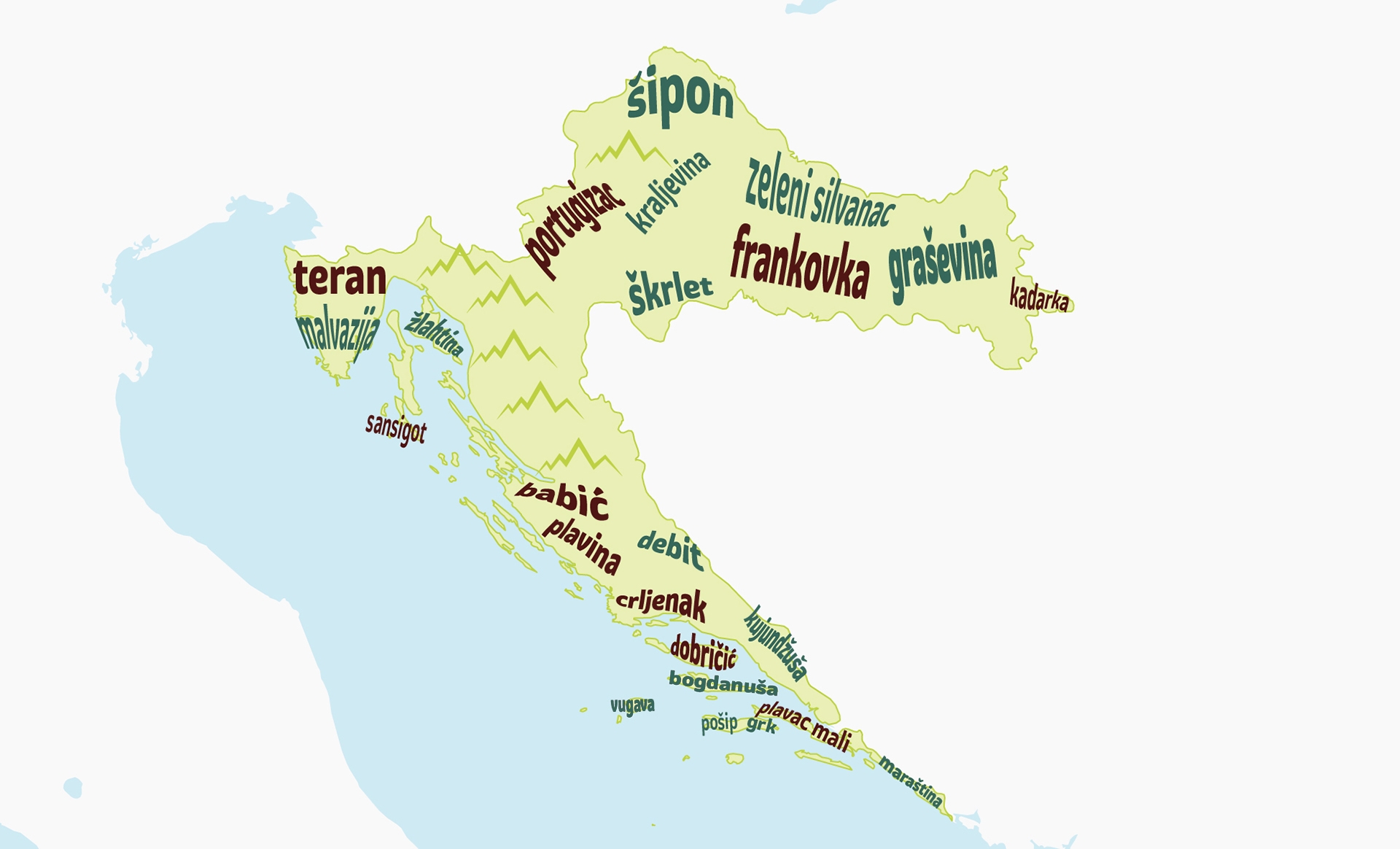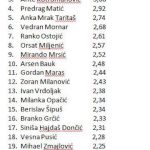 As we have written about the indigenous and abundant wine varieties in Croatian vineyards, we realized that we should make a briefer guide, with key information in one place, to help you understand Croatian wine varieties better.
There were a few ways how we could’ve organized this article, but we decided to go for the colour. So, first take a look at the significant white wines in Croatia (ordered somewhat geographically, from the North to the South).
As we have written about the indigenous and abundant wine varieties in Croatian vineyards, we realized that we should make a briefer guide, with key information in one place, to help you understand Croatian wine varieties better.
There were a few ways how we could’ve organized this article, but we decided to go for the colour. So, first take a look at the significant white wines in Croatia (ordered somewhat geographically, from the North to the South).
significant white wines in Croatia
- Moslavac is a variety not indigenous to Croatia, rather it’s grown around it as well, which explains its many names: Pošipel or Pušipel (but not to be confused with Pošip!), in Slovenia it’s called šipon (and that name is also often heard in Croatia), in Hungary it’s called Furmint, and Germans and Austrians call it Mosler. The grapes ripen late can have quite a lot of sugar in sunnier years and the acids are always quite high. A lower yield needs to be maintained for premium quality wines, including the dessert wines from late-harvest grapes. It’s an inexpensive, refreshing wine, often somewhat sweeter and not too alcoholic, with nice balancing acids.
- Kraljevina sometimes also called Imbrina is a white wine variety indigenous to the region around Zagreb, so-called Prigorje region. The wines are not very alcoholic, but rather high in acids. Usually it’s blended with varieties such as Graševina, and is mostly used for gemišt, but sparkling wines have recently been made from Kraljevina as well.
- Graševina is absolutely not an indigenous variety in Croatia; however it is the most abundant wine variety in Croatia, grown throughout the continental part of the country. It’s a classical mid-European variety, best known under its German name Welschriesling, also called Olascsrizling in Hungary and Laški Rizling in Slovenia. It is a grape that adjusts to many different conditions, and maintains the quality and yield, although the wines made from it can differ significantly. Most Graševina made in Croatia is dry wine, with moderate alcohols, pleasant acids, and lovely varietal aroma and mild tartness – which is a desirable varietal characteristic.
- Škrlet is one of the very few wine varieties in Croatia that have only one name, and that comes from the word “scarlet”, which is how we can describe the colour of its berries. Indigenous to Moslavina region of Central Croatia, the wine made from Škrlet is refreshing, with flowery aroma, rather high acids and low alcohol.
- Zeleni Silvanac is one of the oldest varieties in the Central Europe, and it’s not known where exactly it originated. In Austria and France it’s called Sylvaner, in Germany it’s spelled differently and called Grüner Silvaner, it’s grown in Continental Croatia, mostly in the Orahovica region. The wine is very mild, light, fresh and with accented acids, most often dry and with alcohol content is usually around 13 %.
- Malvazija Istarska, also known by its Italian name Malvasia Istriana is a variety from the large group of varieties, indigenous to the region of Istria, where it is the predominant white wine. It is a versatile variety, allowing different styles for the wine, from young and fresh wine to be consumed within a year, to more serious barrel-aged wine, but it will remain a dry wine with low acidity.
- Žlahtina is often called Vrbnička Žlahtina or Žlahtina Bijela, named after the small town of Vrbnik (on the Northern Croatian island of Krk), where it originates from and where to this day most of the production is located. The wine is clear bright yellow with somewhat exotic fruity aromas, low alcohol content of around 11 percent, usually almost completely dry and refreshing with mineral taste.
- Debit, also known locally in the inland Šibenik region where it’s mostly grown as “Puljižanac” makes a dry, fresh and mineral wine of bright yellow, strong acidity and full of aroma, usually with 11 – 13% alcohol. Dessert wine, known as prošek is traditionally made from the late harvests of Debit.
- Kujundžuša is a wine variety indigenous to the Inland Dalmatian town of Imotski and the sandy fields around it. The wine is usually dry, bright yellow, fresh and light, somewhat mineral and salty, but with soft fruity notes and with low alcoholic content, around 11 %. It’s a fresh wine and does not gain much with aging.
- Bogdanuša is a wine variety indigenous to the island of Hvar, as it was originally found in the Stari Grad Plain on the island. It is a white wine of a very rich greenish-yellow colour, unexpectedly fresh taste, with just the right amount of bitterness and quite low alcohol content, almost always around 12%, and a hint of herbs (lavender!) in the aroma.
- Prč is another wine variety indigenous to the island of Hvar, rarely grown (and used to make wine) on its own, it’s usually blended with other varieties, as it has high yield and accumulates a lot of sugar and can improve the quality of blends. Traditionally, it is used as one of the varieties in prošek.
- Vugava, sometimes also called Bugava is an indigenous variety grown on the stony and sandy soils on the island of Vis. The grapes tend to have very high sugar content and relatively low acids and somewhat overripe aromas. Varietal wine is golden yellow, fruity, less mineral then what you’d expect, well balanced, at around 14 percent alcohol content and a flavour that is sometimes described “retro” and honey-like.
- Pošip is an indigenous variety of the island of Korčula, mostly grown in the sheltered fields on the island, but has been successfully grown in other places in Dalmatia recently (Hvar, Skradin, Brač…). Pošip wine is golden yellow dry, with relatively high alcohol content (sometimes over 14 percent) and very fruity aroma. It ages well, so you can have it as a fresh wine, or aged in oak barrels.
- Grk also originates on Korčula, but from sandy and very dry fields near Lumbarda, that give the grapes very high sugars along with excellent acids. The wine is usually dry, high in acidity, with alcohol content usually around 13 %, somewhat aromatic and fruity with hints of pine and saltiness.
- Maraština is a variety present in most of the Mediterranean, so it has many names – Rukatac is another name used in Southern Dalmatia, Malvasia del Chianti and Malvasia Bianca Lunga are the names used in Italy. It’s grown throughout Dalmatia; traditionally it was used to complement other wine varieties. Varietal wine is fragrant and fruity, golden yellow colour, full-bodied with hints of vanilla, quite low alcohol content and low acids.
Significant red wine varieties in Croatia
- Kadarka is in Hungary often called Gamza, a variety that was once very often seen in Croatia, and these days it exists solely in the Eastern-most region, around the Danube River, with attempts of revival in other parts of Slavonia. With proper yield control, it gives full-bodied wine with gentle tannins, fresh acidity, lightly spicy aromas and overall elegance.
- Portugizac is not an indigenous variety, but has a long tradition all over continental Croatia. It ripens very early, and in Croatia it is usually turned into beaujolais nouveau- type of young wine, fresh, fruity (with berry flavours), quite low alcohols (around 11% usually) and is ready to be consumed 6-8 weeks after the harvest – which is usually in late October. Most Portugizac is produced in Slavonia and Plešivica regions.
- Frankovka is not a Croatian indigenous wine variety; rather it’s indigenous to the region of Central Europe: in Austria and Germany it’s called Blaufränkisch and in Hungary it’s called Kékfrankos. The wine is intensively ruby red, refreshingly fruity in flavour and averages around 13% alcohol content. The tannins are usually quite high, and the acids are just enough to balance the wine. Many producers allow the really good harvests to age in oak.
- Teran, in Italian called Terrano is a variety mostly found in Western Istria, a source of a drawn-out dispute between Croatia and Slovenia. In good positions it givesalmost purple wine of a fruity aroma that is easy to recognize, unusually high acidity and high tannins and not too high alcohol content: 12 – 13%. It’s usually enjoyed as a young wine, as the traditional wisdom is that it does not age too well.
- Sansigot, sometimes also called Sušćan, is a variety indigenous to a very small sandy island in Mali Lošinj archipelago, Susak. It has spread to other Kvarner islands, like Krk, Cres and Pag. It manages to acquire acceptable levels of sugar and matching good levels of overall acidity, resulting in wines not too strong, not too high on tannins and to be enjoyed as a young wine or after some aging.
- Babić is a wine variety indigenous to the Central Dalmatia region, in areas near the coastline and on some islands in the region. The wine has a full taste, earthy and mineral, with just enough acidity to balance the high alcohol and tannins. Premium Babić is sometimes aged in oak barrels and the results are amazing!
- Plavina, also called Plavka or Plajka is the sixth most widespread indigenous variety in Croatia. The wines it gives are usually lighter (around 11 or 12 percent alcohol content), not too dark in colour, relatively fresh and somewhat lack any characteristic flavour – it’s rather neutral, one might say. It is almost always blended with other varieties, and often used for the production of prošek.
- Dobričić is one of the parents of Plavac Mali and that is probably its greatest claim to fame. Today, you can find varietal wines only on the island of Šolta, and it’s sometimes called “the darkest red wine of Dalmatia”, with low alcohols and low acids, but high in tannins, almost tart and bitter and needs to age in oak.
- Darnekuša, also called Drnekuša on Hvar or Glavanjuša on Vis (and it grows exclusively on those two islands!) is a variety rarely planted and made into wine on its own; usually it is blended with Plavac Mali or used in prošek. Some great light red and rosé wines have recently been made from it.
- Plavac Mali is probably the most important red wine variety, grown throughout Dalmatia – on the Pelješac peninsula, the islands of Hvar and Brač, and vineyards in Konavle region. The sugar content in very sunny positions can get extremely high, and the resulting alcohol also gets quite high (up to 17 %!), with usually high tannins. The flavour is rustic, with hints of dark berries, cherry, pepper and spice, and the wine has excellent aging capabilities, and is often aged in oak barrels.
- Tribidrag is a wine variety of Croatia with the largest number of names: you can call it Tribidrag, or Pribidrag, sometimes you’ll see it on the wine list as Crljenak Kaštelanski. In Italy they call it Primitivo, and it’s one of the most popular varieties in the US under the name Zinfandel. It’s a parent of Plavac Mali, and has recently been re-introduced to Croatian vineyards. The wine is similar to Plavac Mali (especially when it’s grown on similar locations), wonderfully deep red, with lower tannins and aroma of berries and spices.
Do you want to try Croatian wines?
If you want to savor the exquisite flavor of Croatian wines, look no further than wineandmore.com. Offering a wide range of wines from various winemakers, you can easily find what suits your palate.
Do you need help selecting the right wine bottle? Try one of their curated wine cases, and find the perfect vintage for any occasion!









